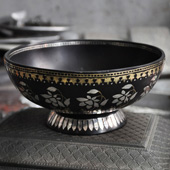Design Resource
Bidri-ware - Hyderabad
Handicraft of Bidar
by
Melting the Alloy:
Each Bidri pieces cast separately from ordinary soil made malleable with castor oil and resin. Processed 95% Zinc and 5% copper metal is melted at a temperature of 800F. The molten metal alloy is poured in to the mold formed. The mold is allowed to cool and the object is removed. The surface of a newly cast piece is rough, so it is made smooth with filing and buffering.
Casting the Article:
The article is then rubbed with copper sulphate solution to obtain temporary black coating on which the designs are etched. All the designs are drawn free hand on the matt black surface with the sharp metal tool called stylus.
Engraving and inlaying the design:
Bidri ware is firmly fixed on a waxed stone to hold it in a way to engrave the designs on the article. The artisan uses small chisels to engrave the design. Pure silver is converted into fine flat wires and hammered or inlaid carefully into these chiseled grooves. Silver metal sheets also inlaid if the design motif dimensions are wide.
Geometrical designs are created with silver wire. Wherein, the floral arabesques and intricate leaf patterns are designed with silver metal sheet. After the inlaid work is complete the article is rigorously filed to obtain smoother surface.
Oxidizing:
In this stage bidri item is ready for the final step, to make the surface permanently black so that the silver inlay design will stand out in bright contrast against the dark background. A particular type of soil found in the inner depths of ruins in building particularly brought from Bidri fort, which are three hundred years old and where neither sunlight nor rain has fallen from many years. This soil when mixed with ammonium chloride and water produces a very special solution. This solution is boiled at an accurate temperature and the bidri article is dipped in this solution. The solution has a special oxidizing property which when reacted with the alloy, darkens the body of product but has no effect on the inlayed silver wires. The article is then rinsed off in normal water leaving the silver shinning against the black surface. Finally oil is rubbed on the piece to deepen the black matt coating.





















